
The Cessna 150 is a two-seat tricycle gear general aviation airplane that was designed for flight training, touring and personal use. In 1977, it was succeeded in production by the Cessna 152, a minor modification to the original design.
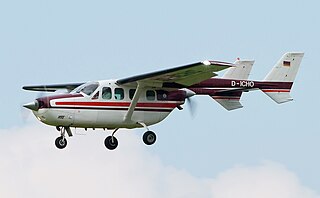
The Cessna Skymaster is an American twin-engine civil utility aircraft built in a push-pull configuration. Its engines are mounted in the nose and rear of its pod-style fuselage. Twin booms extend aft of the wings to the vertical stabilizers, with the rear engine between them. The horizontal stabilizer is aft of the pusher propeller, mounted between and connecting the two booms. The combined tractor and pusher engines produce centerline thrust and a unique sound. The Cessna O-2 Skymaster is a military version of the Cessna 337 Super Skymaster.

The Sikorsky Cypher and Cypher II are types of unmanned aerial vehicles developed by Sikorsky Aircraft. They are vertical takeoff and landing aircraft which use two opposing rotors enclosed in a circular shroud for propulsion.
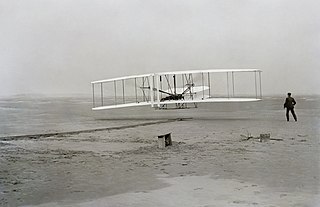
In an aircraft with a pusher configuration, the propeller(s) are mounted behind their respective engine(s). Since a pusher propeller is mounted behind the engine, the drive shaft is in compression in normal operation.

An aircraft constructed with a push-pull configuration has a combination of forward-mounted tractor (pull) propellers, and backward-mounted (pusher) propellers.

The Beechcraft Musketeer is a family of single-engined, low-wing, light aircraft that was produced by Beechcraft. The line includes the Model 19 Musketeer Sport, the Model 23 Musketeer, Custom and Sundowner, the Model 23-24 Musketeer Super III the retractable gear Model 24-R Sierra and the military CT-134 Musketeer.

The Cessna 401 and 402 are a series of 6 to 10 seat, light twin-piston engine aircraft. This line was manufactured by Cessna from 1966 to 1985 under the name Utiliner and Businessliner. All seats are easily removable so that the aircraft can be used in an all-cargo configuration. Neither the Cessna 401 nor the 402 were pressurized, nor were they particularly fast for the installed power. Instead, Cessna intended them to be inexpensive to purchase and operate.

The Cessna 177 Cardinal is a light single-engine, high-wing general aviation aircraft produced by Cessna. It was intended to replace the Cessna 172 Skyhawk. First announced in 1967, it was produced from 1968 to 1978.

The Cessna 421 Golden Eagle is an American six or seven seat twin-engined light transport aircraft, developed in the 1960s by Cessna as a pressurized version of the earlier Cessna 411.

The Cessna 340 is a twin piston engine pressurized business aircraft that was manufactured by Cessna.

The Anderson Greenwood AG-14 is a two-seat utility aircraft developed in the United States shortly after World War II. It is an all-metal, shoulder-wing monoplane of pod-and-boom configuration, equipped with a pusher propeller, side-by-side seating and fixed tricycle undercarriage.

The Piaggio P.136 was an Italian twin-engine amphibian flying boat designed and manufactured by aircraft company Piaggio Aero. It is furnished with an all-metal hull, pusher propellers, a gull wing, and retractable landing gear.
The Bede XBD-2 was an experimental short takeoff and landing (STOL) aircraft, with several novel features such as structural use of glass-fibre and aluminium honeycomb, a suction boundary layer control (BLC) system and fuselage-mounted twin engines driving a pusher configuration, shrouded single propeller. The sole example flew in the early 1960s in the United States.

The Rabouyt D2 was a two-seat autogyro, with an engine driven rotor for vertical take-offs. In level flight the aircraft was powered by the same engine driving a shrouded, pusher configuration propeller. It was designed and built in France in the early 1970s by Denis Rabouyt.
The Miller JM-2 was an American Formula One Air Racing homebuilt aircraft that was designed by Jim W Miller and produced by JW Miller Aviation of Marble Falls, Texas. When it was available the aircraft was supplied in the form of plans for amateur construction.
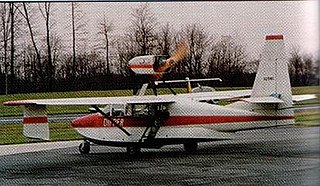
The Collins Dipper was an American homebuilt flying boat that was designed and produced by Collins Aero of Chadds Ford, Pennsylvania and first flown in 1982. The aircraft was supplied in the form of plans for amateur construction. Only one was built and none remain registered.
The Convair Model 106 Skycoach was an experimental four-seat light aircraft, designed and built by the Stinson Division of Convair at the end of World War II.
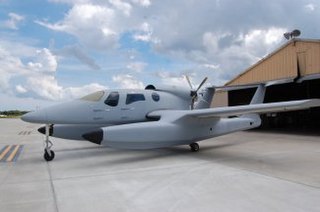
The Privateer Industries Privateer is an American amphibious amateur-built aircraft that was designed by John Meekins and Bill Husa and is under development by Privateer Industries of Florida. It was first flown on 6 August 2018. The aircraft is intended to be supplied as a kit for amateur construction and later type certified and sold as a complete ready-to-fly-aircraft.
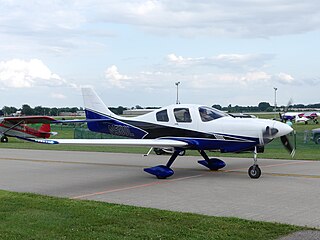
The Lancair Mako is an American amateur-built aircraft designed and produced by Lancair of Uvalde, Texas, introduced at AirVenture in 2017. The aircraft was first flown on 18 July 2017 and is supplied as a kit for amateur construction. It is named after the shark.

The VoltAero Cassio is a family of hybrid electric aircraft being developed by startup company VoltAero. The company plans to produce three configurations of the Cassio aircraft: the four-place Cassio 330, the six-place Cassio 480, and the ten-place Cassio 600.

















